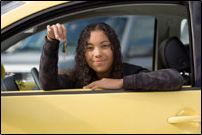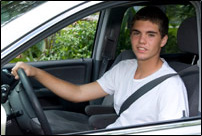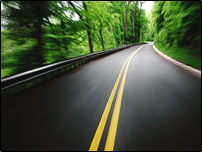- Crash rates are the highest during a teen's first few months behind the wheel.
- Sixteen year-olds have by far the highest crash risk of drivers of any age and making them 10 times more likely to be involved in a crash than an adult.
 Between 2007–2011, an average of 15,801 crashes involving young drivers occurred on Maryland's roadways.
Between 2007–2011, an average of 15,801 crashes involving young drivers occurred on Maryland's roadways.- During those same years, an average of 87 people lost their lives each year in crashes involving a driver 16-20 years old. This loss of life represents close to 16% of all of Maryland's traffic fatalities.
- Between 2007–2011, an average of 9,546 people were injured annually, due to young-driver involved crashes, accounting for 20% of all Maryland's traffic injuries.
- In those same years, drivers ages 16–18 represented 20% of all those injured in young driver involved crashes.
- Sixteen and 17-year-old drivers represent only 1.6 of all licensed Maryland drivers, and 1.3% of all miles driven, but these drivers represent 11% of all driver fatalities, on average.
*Crash data source: State Highway Administration Safety Information Database
It takes about 1,500 skills to drive behind the wheel – observation, perception, interpretation and anticipation – all occurring in the brain which American Medical Association studies show does not reach full maturity until mid-to-late 20s. Young Drivers are often at risk for being involved in crashes due to driver inexperience and immaturity. Inattention, poor driving strategies and high-risk behaviors continue to be problem areas with young drivers. Parent involvement during the learner's permit and provisional licensing periods is a critical component of a comprehensive approach to young driver safety.
National Statistics:
- Nationally, the crash risk per mile driven by 16 year-olds is twice that for 18-19 year-olds and about 7 times the risk for drivers ages 30-59.
- Motor vehicle crashes are the leading cause of death for teens in the U.S.
- Each year, more than 5,000 teens (ages 16-20) are killed in passenger vehicle crashes.
- Nationally in 2010, 25% of the young drivers ages 15-20 who were killed in crashes had Blood alcohol concentration (BAC) levels of .08 or higher at the time of the crash.
- Nationally in 2010, 5,021 teen passenger vehicle occupants, ages 16 to 20, were killed in motor vehicle crashes.
- According to the National Highway Traffic Safety Administration (NHTSA), teenage drivers and passengers are among those least likely to wear their seat belts.
- While all teens are at a high-risk of experiencing a fatal crash, according to NHTSA, young males, pickup truck drivers and passengers, as well as people living in rural areas are also among those least likely to buckle up.
Current Young Driver Laws
Click here to find out more about the requirements of Maryland's graduated licensing system.
Teen Driving Laws in Maryland
Maryland is concerned about the safety of new drivers, and has strengthened the laws. The following outlines the requirements for all those who are learning to drive and are graduating through the Maryland Rookie Driver: Graduated Licensing System. Anyone obtaining a learner's permit or provisional driver's license should take note of all the provisions of Maryland's graduated licensing system.
Learner's Permit Holders:

- The learner's permit driver must complete a minimum of 60 hours of driving practice with someone at least age 21 who has held a driver's license for 3 years or more.
- A minimum of 10 of the 60 practice driving hours must occur at night. The nighttime practice driving can occur 30 minutes before sunset, but no earlier, or 30 minutes after sunrise, no later, to qualify as nighttime practice driving. A practice driving skills log must be signed by an individual certifying the practice driving requirements were fulfilled.
- Under age 16 must submit a completed Learner's Permit School Attendance Certification Form. This form must be validated by a school official or authorized home school coordinator prior to applying for your permit.
- Learner's permit holders under 18 may not use any wireless communication device, including a cell phone, while driving, except to make an emergency 911 call. Violations may result in the suspension of one's driving privilege for up to 90 days.
Learner's Permit Requirements:
| Learner’s Permit Holder Requirements (by age) |
Age 18 or under (without HS diploma or GED) |
18 years old (with HS diploma or GED) |
Ages 19-24 |
| Minimum holding period before skills test |
9 months |
3 months |
3 months |
| Supervised practice driving hours |
60 hours |
60 hours |
60 hours |
| Required practice hours at night |
10 hours |
10 hours |
10 hours |
Provisional Driver's License Holders:
- Minimum age is 16 years and 6 months.
- Cannot obtain a full license until they reach the age of 18.
- Under 18 are still prohibited from transporting any passenger under age 18 for 151 days after the provisional license is issued. There is an, exception for direct family members (spouse, daughter, son, stepdaughter, stepson, sister, brother, stepsister, or stepbrother of the provisional license holder) and relatives of the license holder who lives at the same address. Violations may result in a suspension of one's driving privilege.
- Drivers under the age of 18 may not use any wireless communication devices, including a cell phone, while driving, except to make an emergency 911 call. Violations may result in the suspension of one's driving privilege for up to 90 days.
- Drivers must hold the provisional license for 18 consecutive months with no moving violations. Any violations or probation before judgment rulings will mean the 18 month period must be restarted.
- Provisional drivers are ineligible for a PBJ ruling from the court if the defendant has previously received a PBJ for a moving violation, or criminal offense.
- Can have their license canceled if, while they are still a minor, the cosigner of the license application requests in writing that the MVA cancel the product.
- Under age 18 face serious penalties for repeated violations and offenses. Penalties for repeated violations can include:
- Mandatory completion of driver improvement program (DIP).
- The retaking of all law and driving skills tests.
- License suspension for an accumulation of excessive points within a 12-month period, for repeated convictions of PBJ's during the provisional period or conviction on an offense classified as high risk driving.
- Revocation of your driver's license.
Converting To A Full Driver's License

- A driver must be at least 18 years of age.
- The provisional license must be held for 18 months with the driver free of moving violation convictions. If convicted, the driver must restart an 18-month waiting period with no additional moving violations. Only then can a driver become eligible to convert to a full driver's license.
For any license type:
If you are under the age of 21 and found to have been driving under the influence of drugs or alcohol (DUI), your license will be suspended for ONE YEAR. If you are found to have been driving while under the influence a second time, your license will be suspended for TWO YEARS.
Young Driver Things to Know:
- Teen drivers have the highest crash risk of any age group.
- The risk of a 16 year old driver being killed increases by 86% with two passengers, and nearly triples with three passengers.
- Per mile traveled, they have the highest involvement rates in all types of crashes, from those involving only property damage to those that are fatal, according to NHTSA
How are Teen crashes different?
 According to a joint publication by the Insurance Institute for Highway Safety and NHTSA, the following are characteristics of teens' crashes:
According to a joint publication by the Insurance Institute for Highway Safety and NHTSA, the following are characteristics of teens' crashes:
- Driver error: Compared with crashes of older drivers, those of 16 year-olds more often involve driver error.
- Speeding: Sixteen-year-old drivers have a higher rate of crashes in which excessive speed is a factor.
- Single-vehicle crashes: More of 16 year-olds' fatal crashes involve only the teen's vehicle. Typically, these are high-speed crashes in which the driver lost control.
- Passengers: Sixteen year-olds' fatal crashes are more likely to occur when other teenagers are in the car. The risk increases with every additional passenger.
- Alcohol: Although this is a problem among drivers of all ages, it's actually less of a problem for 16 year-olds. 15% of fatally injured 16-year-old drivers in 2010 had positive blood alcohol concentrations (BACs) of 0.01% or greater.
- Night driving: This is a high-risk activity for beginners. Per mile driven, the nighttime fatal crash rate for 16 year-olds is about twice as high as during the day.
- Low belt use: Teenagers generally are less likely than adults to use safety belts.
Profile of a young driver-involved crash in Maryland - 2010
Who:
- Men are over represented in young driver crashes. (56%)
- Young drivers between 18 and 20 have higher crash percents than their younger and older counterparts.
Where:
- Baltimore County was over represented in young driver crashes. (2,532)
- Prince George's, Montgomery, Anne Arundel counties and Baltimore City had the next highest number of total young driver-involved crashes (1,835; 1,808; 1,722 and 1,501 respectively)
- Two-thirds of the total young driver-involved crashes occurred on state and county highways, 35.2% and 31.5% respectively
When:
- Young driver crashes are highest on Fridays but, Saturday also had a high number of young driver crashes.
- The highest percentage of young driver crashes occurs between 3:00 pm and 7:00 pm.
Resources and Links

